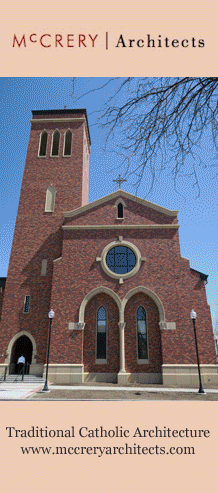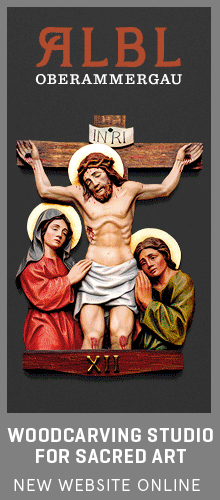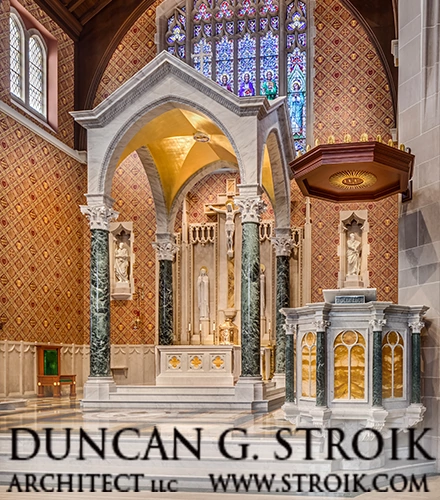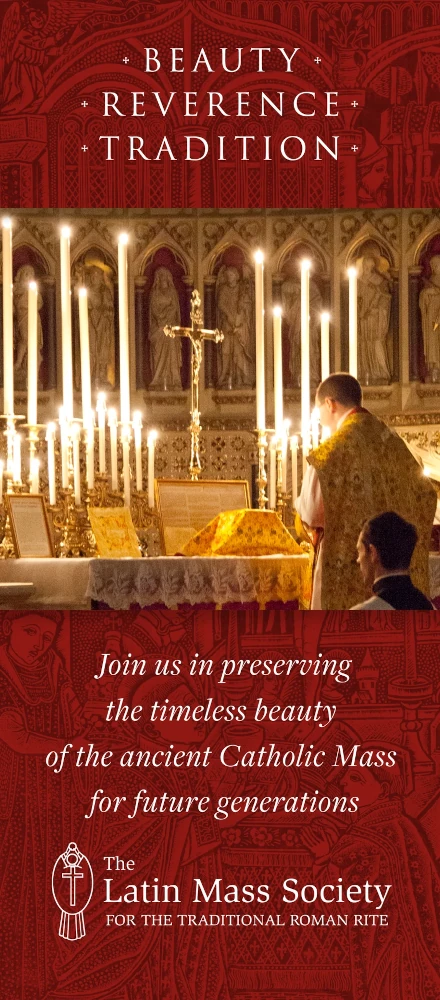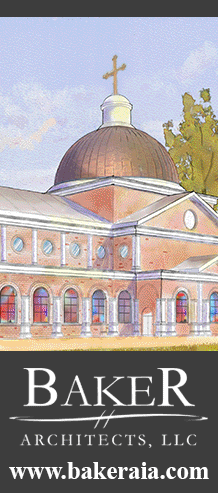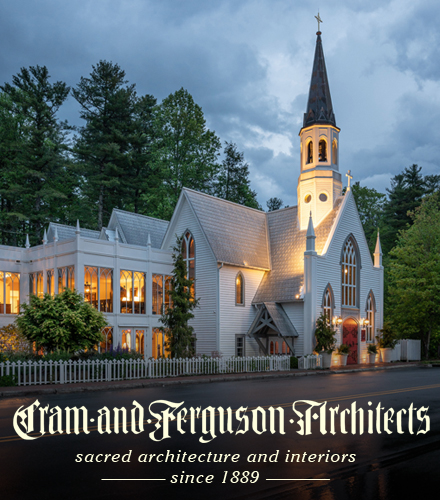A Liturgical Curiosity
Originally posted on the Holy Whapping March 25, 2004, while the author was studying in Rome and frequenting the miniscule FSSP parish of San Gregorio ai Muratori.
It always surprises me that the solemnity of the Annunciation of our Lord isn’t a holy day of obligation. I find myself blinking in surprise as I check the Code of Canon Law yet again to see if it’s one of the big ten that we’re still responsible for. Unless, of course, it falls on a Saturday or a Monday or in the Jewish lunar month of Cheshvan during a leap year, all those Byzantine attempts to make the layman’s life simpler. In the Middle Ages, it was Ladymas or Lady Day, the first day of the new year, the traditional date of the Crucifixion just as it was of the Incarnation and the Creation, and the day the world would someday end.
Nonetheless, I turned up at San Gregorio at six thirty this evening, that familiar, humble church door at the end of a dark, nondescript alley. I paused in the claustrophobic dark wooden sentry-box fitted over the inside of the door, the bussola that climate and custom has provided all of Rome’s churches with in lieu of a narthex. And I found myself fumbling with the doorknob, realizing it was the right-hand door they left unlocked and popped into San Gregorio.
I’d lied—it wasn’t six-thirty exactly, maybe a bit after it. I was, as usual, fashionably late. They were already at the Kyrie, whispered sotto voce, when I entered, and unfortunately my first thought was some snarky comment about the astonishingly ugly pattern of bright-red poinsettias on the priest’s Roman chausible and matching chalice-veil, atrocious petalled scarlet against the mandated white for the feast of the Virgin.
I tried to orient myself, straining my ears to make out the intimate mumblings of the server and the priest, and quietly backtracked over to the rear pew to snatch up a bilingual missal. Then, I realized, over at the side altar not two yards away from the sanctuary in this tiny oratory, Father Tomas was beginning a whole other mass by himself. Things had suddenly gotten very, very confusing: I had received the singular privilege of Tridentine instant-replay. The whisperings suddenly turned to Latinate mush, the snakelike sibilants of the letter s that are the one sound you can’t ever truly whisper, interlocking and interlacing into an inverted Pentecost—in other words, Babel.
Father Tomas. I’d recognize the back of that head anywhere. He’s really still a kid, a little Croatian with cropped yellow hair, round steel-rimmed spectacles and an impeccably-tailored cassock and long black cloak that could have come out of a Bing Crosby-era clerical supply catalog. Or, in the gilded robes and falling sweeps of laced alb he had selected for the solemnity, out of a forgotten, smoke-darkened Counterreformation altarpiece of one of those passionate young Jesuits, Aloysius, Stanislaus or John Berchmans the Belgian.
He moved to the center of his side-altar with drill-field precision, turning and strutting and turning again to kiss the relic beneath the three layers of consecrated cloth, addressing his low responsories to no one in particular. Oramus te Domine, per merita Sanctorum tuorum, quorum reliquiae hic sunt, et omnium Sanctorum: ut indulgere digneris omnia peccata mea. Amen. His biretta lay neatly on the wooden footpace of the altar, looking primly forlorn. I tried not to be amused, but the utter dazzling confusion of the sight of two priests with their back turned offering two separate masses within earshot of one another was—God forgive me—weirdly comic. Or perhaps the way I was reacting was the origin of the humor in this situation. It just seemed like some strange optical illusion, Latinate déjà vu all over again as my eyes clicked back and forth from priest to priest.
No—wait—up in the little tile-floored sanctuary, the two lonely candlesticks of low mass lit with little wavering flames, they’d just ascended the altar-step. Maybe they were at the Confiteor when I came in, not the Kyrie. I heard more intricate mutterings, and tried to wedge in a whispered Christe eleison from the pew between the quick exchanges between the be-poinsetta’d celebrant and the server. Now, the Gloria—oh yes, for a feast, of course, wrapped in silent and frustrating gauze as Tomas continued his own mass at the side. A white-haired old man had joined him below the creaky footpace and was quietly answering his responses. Now they were at the Gloria, and I tried to offer my continuing confusion up to God having nothing else to give. Something, anything to salvage my utter bewilderment.
I have to admit, though, my first thought when the battle of the dueling celebrants began, was simply that there was no way I wasn’t going to write about this, it was just too singular an opportunity to miss. It’s a struggle sometimes, the impulse to play liturgical tourist and lose yourself in descriptions of orange silk maniple-linings flashing in semidarkness, of liturgical osculae and triplicate crossings, or even semi-comic ecclesial curiosities like the odd tableau that I had stumbled into on Lady Day. And it’s a struggle even to admit it’s a struggle, as even that makes for interesting writing. I tried my best to get back to my prayers, hoping whatever came out of this, either in my soul, my head, or my journal, that it was for God and not my amusement. I tried to bury myself in the little paperback missal, over-carefully reading the private prayers to re-orient myself.
Concelebration, the rite of several priests consecrating together the sacred Victim at mass, was virtually unheard-of in the days of Pius V, when the old mass was first fully codified as a weapon against the religious strife that then wracked Europe. Before the Council fathers had sat in snowy Trent, the custom had died out, but not before St. Thomas could defend it and Durandus deny it. By the sixteenth century, it had been reduced to a peculiarity of the Ordination mass, the one time that the words of Consecration were said in anything more than a whisper. By necessity—to keep the newly-chrismed priests, their chausibles still folded up on their backs, in time with their leader, the bishop.
But otherwise, for better or worse, for all its ubiquity today, it was unknown then. The endless ranks of splendidly-marbled side-altars in so many churches are a testament to this liturgical quirk, allowing every priest to have his private mass every day of the year. Churches rang with the staggered sound of sacring bells, one Consecration coming after the other with imprecise precision. Priests even complained, as the golden sky of the Middle Ages slowly rolled up into the apocalyptic scroll of the Reformation, of pious laymen rushing from chapel to chapel to adore the upraised host in mass after mass.
And here was I, living on a page of liturgical history and trying to pray and not to gawk. To look and not stare. I considered fumbling with my rosary, but turned back to the missal balanced on the pew-rail.
My eyes kept slowly wandering back and forth between the two priests. I watched the old celebrant at the high altar bow with slow familiarity, assisted by a bespectacled, black-cassocked old acolyte.
And I watched Tomas as well, resplendent in his kingly vestments shot with gilt black-graped vines, move through the ritual with the graceful over-enthusiasm of the neophyte, laying on signs of the cross with the vigor of a tomahawk chop, cutting the air over the paten and chalice with a balletic and solemn slice of his hand. He is growing slowly into his priesthood, and it is marvelous to watch, as I did at high mass this last Sunday, Laetare Sunday, as this innocent, unprepossessing-looking creature turns to his server, hand pressed to his silk-clad breast, and gives a stiff little blessing with his forefinger touched to his thumb, the pardon before Communion. Possibly the most beautiful gesture in the world.
Indulgentiam absolutionem + et remissionem peccatorum nostrorum, tributat nobis omnipotens et misericors Dominus.
Communion—but not yet. I strained to listen for the Sanctus and tried to hang onto the words as the server rang the altar bell three times, and then silence. A single moment of silence at both altars, and then even lower, more secret whispers. Another bell, and I waited in anticipation, as the Host was raised on high, almost piercingly white against the dark canvas of the reredos.
I’d missed Mass twice over the last few days, and perhaps that’s why He seemed so glaringly present, not in some mystical sense, of course, but there was a certain odd solidity about that sacred Disk of bread that was not bread in this collision of liturgical tableaux. And then I found myself waiting again, eagerly, excitedly, as I looked over to my left and saw the same miracle happen one more time, a doubling of Calvaries like Christ in a sacred temple of mirrors—yet it was no reflection I saw. Time loops in on itself at every mass, bringing us back to Golgotha, and here I had the unique privilege of seeing God do the impossible two times in a row.
Staggered humilities, flavored by different accents. Nobis quoque peccatoribus. And then again from the side altar, in Croatianized Latin, more subtly, more murmured. Nobis quoque peccatoribus. Though we are sinners, the only words of the old Canon said aloud.
I saw the priest at the main altar kneel slowly as he worshipped the Host, and then noticed Father Tomas out of the corner of my eye fall on his knees, almost seeming to strain as he fell onto the footpace with a great clatter to reverence the God He had just brought back down to earth. Two reverences, two men, one Lord.
And I quietly went over to the altar-rail and took the Host silently. No response, the missal had admonished me, no response to the priest’s complex quadripartite gesture with the Host (And the absentminded, gentle blessing of Corpus Domini nostri Jesu Christi custodiat animam tuam in vitam aeternam. Amen.) The mass soon ended with the Last Gospel, said so silently as if one had to take the instruction to genuflect at et Incarnatus est on faith from the priest. He left then, the chalice veiled in his hands, the black biretta square on his head like a curious piece of Roman origami. But Father Tomas was still at his side-altar, bowing low again and again as he prayed the last series of blessings, scarlet vestment linings flashing in the semidarkness, the dangling stole with fishtailed ends bouncing against his knees. And so I joined him, thinking he might appreciate a congregation as I stood sideways in the pew.
As he turned around to impart the final gesture with a simple crossing, I waited and wondered if perhaps he might notice me—but then I looked up, watching his skinny hands impart the sign, and realized his head was bowed, his eyes almost closed in serene, intensely-controlled mysticism.
It didn’t matter. It didn’t matter to him who was listening, who was there. It hadn’t even mattered if he had a server to say all the Et cum spiritu tuos at the beginning, the old man had come to him, not the other way round. As a favor, maybe, like I had.
I remembered the words in the missal, black on white. Three times, three taps of the breast.
All. Domine, nom sum dignus et intres sub tectum meum; sed tantum dic verbo, et anabitur anima mea.
All. Lord, I am not worthy that Thou shouldst come under my roof. But only say the word and my soul will be healed.
Only say the word. Words, words and silence and secrecy and eyes sealed shut in communion with God. A strange mass, with the silent Canon and Consecration of the old rite, to attend on the feast of the Annunciation, that day so full of words, Ave Gratia Plena exclaimed aloud, words that could trouble a sinless virgin because they were understood and not lost in a stream of jarring whispers. Words and the Word, and the Word that entered through the ear of a Virgin and went straight into Her womb.
I am not sure I like the silent Canon of the old mass, but I know well enough to respect it. And I hope I understood it better on this day of loud and sacred words, of that grand seraphic greeting painted on so many unfolding Germanic triptychs of centuries past. Because the word of the Annunciation, the word that mattered, was not the angelic salutation of Gabriel but the word that came in secret from the overshadowing Holy Spirit and dwelt for nine months in secrecy within the Virgin’s womb just as the priest stands in silence bent over the altar whispering the unchanging words of Consecration and the alter Christus brings Christ into the world.
Of course he had his eyes closed. It was not about him, this mass. It was about something else. Someone else, with a name, and, because of a teenaged girl in Nazareth, a human face. And for Her, it was not about Herself either, but Someone else too. Ecce ancilla Domini. Fiat mihi secundum verbum tuum. Be it done unto me according to Thy Word.
Tuesday, August 23, 2005
Ancilla Domini in Stereo
MatthewMore recent articles:
The Apple of Her EyeDavid Clayton
“The Lord God planted a garden in Eden, which is in the east, and there he put the man he had fashioned. From the soil, the Lord God caused to grow every kind of tree, enticing to look at and good to eat, with the tree of life in the middle of the garden, and the tree of the knowledge of good and evil.” (Gen. 2, 8-9) This 17th century painting...
The Exposition of the Holy Lance at St Peter’s BasilicaGregory DiPippo
The YouTube channel of EWTN recently published a video about the exposition of the Holy Lance at St Peter’s basilica on the first Saturday of Lent. This was formerly done on the Ember Friday, which was long kept as the feast of the Holy Lance and Nails, but since this feast is no longer observed, the exposition of the relic has been transferred to ...
The Feast and Sunday of St John ClimacusGregory DiPippo
In the Byzantine liturgy, each of the Sundays of Lent has a special commemoration attached to it. The first Sunday is known as the Sunday of Orthodoxy, because it commemorates the defeat of iconoclasm and the restoration of the orthodox belief in the use of icons; many churches have a procession in which the clergy and faithful carry the icons, as...
The Story of Susanna in the Liturgy of LentGregory DiPippo
In the Roman Rite, the story of Susanna is read as the epistle of Saturday of the third week of Lent, the longest epistle of the entire year. This episode is not in the Hebrew text of Daniel, but in the manuscripts of the Septuagint, it appears as the beginning of the book, probably because in verse 45 Daniel is called a “younger man”, whic...
A New Edition of the Monastic Breviary Available SoonGregory DiPippo
The printing house of the Monastère Saint-Benoît in Brignole, France, Éditions Pax inter Spinas, is pleased to announce the re-publication of the two volumes of the last edition (1963) of the traditional Latin Monastic Breviary.The Breviary contains all that is necessary to pray the complete Monastic Divine Office of Matins, Lauds, Prime, Terce, S...
A Mid-Western Saint from Rome: Guest Article by Mr Sean PilcherGregory DiPippo
Thanks once again to our friend Mr Sean Pilcher, this time for sharing with us this account of the relics of a Saint from the Roman catacombs, which were brought to the cathedral of Dubuque, Iowa, in the 19th century. Mr Pilcher is the director of Sacra: Relics of the Saints (sacrarelics.org), an apostolate that promotes education about relics, and...
Fons et Culmen Sacred Liturgy Summit - July 1–4, Menlo Park, CaliforniaJennifer Donelson-Nowicka
You are cordially invited to the Fons et Culmen Sacred Liturgy Summit, which will be held from July 1-4, in Menlo Park, California!Fons et Culmen Sacred Liturgy Summit gathers together Catholics who love Christ, the Church, and the Church’s sacred liturgical tradition for: - the solemn celebration of the Mass and Vespers; - insightful talks on...
A Lenten Station Mass in the Roman ForumGregory DiPippo
Today’s Mass is one of the series instituted by Pope St Gregory II (715-31) when he abolished the older custom of the Roman Rite, by which the Thursdays of Lent were “aliturgical” days on which no Mass was celebrated. The station appointed for the day is at the basilica of Ss Cosmas and Damian, which was constructed by Pope St Felix IV (526-30) in ...
Do Priests or Religious Need Special Permission to Pray a Pre-55 Breviary?Peter Kwasniewski
On occasion, I receive an email like the following (in this case, from a seminarian): “Do you happen to know of any sources/authoritative references which you could point me to that explain why praying the Pre-55 Breviary definitely satisfies the canonical obligation for clerics or religious? As I am strongly desirous of the Pre-55 Liturgy, I ...
Early Bird Registration Discount for CMAA Colloquium Ends March 31st!Jennifer Donelson-Nowicka
Join us this summer for world-class training in the Church’s treasury of sacred music.Early bird registration discount ($50 for colloquium, $50 for Vocal Intensive course, $150 off for Chant Intensive) ends March 31st!Here’s a special invitation from our new president, Fr. Robert Pasley.The Church Music Association of America is pleased to announc...


